NWEA MAP Test: The Ultimate Guide [Including Free Practice Questions]
This is a complete preparation guide for the NWEA MAP Test, also known as the MAP Growth test.
Using this guide, you’ll:
- Understand exactly what to expect on the test
- See what actual questions look like
- Learn how to prepare effectively
- Get answers to the most common questions about the test
So if you want to know everything about MAP testing and help your child prepare and score high, you’ll love this page.
Let’s get started!
Get to Know the MAP Growth Test Inside Out
What Is the NWEA MAP Growth Test & What’s Its Purpose?
The NWEA MAP (Measures of Academic Progress) test is an adaptive assessment designed to measure a student’s academic growth and proficiency. This computerized test dynamically adjusts its difficulty based on a student’s responses, providing a personalized evaluation of their knowledge and skills.
MAP testing has been in use for over four decades, with a rich history of helping educators tailor their teaching strategies to individual student needs.
Unlike many standardized tests, MAP testing is not a one-size-fits-all evaluation; it adapts to each student, offering a more accurate and comprehensive view of their academic progress.
The MAP test is not limited to a specific state but is widely used across the United States, providing valuable insights into student performance on a national scale.
The duration of MAP testing varies, but on average, students spend approximately 45-60 minutes per subject, allowing for a thorough evaluation of their skills and knowledge.
How Many Questions Are on the MAP NWEA Test (Math, Reading, Science)?
The NWEA MAP Growth test typically consists of 40 to 43 questions per subject—Math, Reading, and Science.
| Test Type | Purpose | Available for | Approx. Length/Duration | Score in Reports |
|---|---|---|---|---|
| MAP Growth, Grades 2+ | Measure achievement and growth, inform instruction, and assess strategy | Reading, language usage, math (including course-specific material), and science (including course-specific material) | 40 to 43 questions; about 45 to 60 min. | RIT score (subject and instructional areas), shown in most reports; Learning Continuum statements; Lexile® score |
| MAP Growth, Grades K–2 | Measure achievement and growth, inform instruction, and assess strategy | Reading and math | 43 questions; about 40 min. (given in two 20-min. sessions) | RIT score (subject and instructional areas), shown in most reports; Learning Continuum statements; Lexile® score |
In the Math section, questions cover various mathematical concepts, while the Reading section assesses comprehension and critical thinking. The Science section delves into scientific concepts and reasoning.
How Often Is MAP Testing Done in a School Year?
MAP testing is typically conducted three times a year—fall, winter, and spring—providing educators with valuable insights into students’ academic growth.
It’s important to note that MAP tests are not designed for retakes, emphasizing the importance of genuine responses. While NWEA discourages retesting for reasons other than test-related issues like fatigue or stress, the decision ultimately rests with the district.
What Kind of MAP Testing Is Your Child Taking?
Understanding the specifics of your child’s MAP testing is pivotal for informed parental support. For instance, if your child is in Grades K–2, they will be taking the MAP Growth K–2 assessment, focusing on reading and math.
On the other hand, if your child is in Grades 2 and above, they are likely participating in the MAP Growth assessment, covering subjects like reading, language usage, math, and science.
Being aware of these distinctions equips you with valuable insights into the focus areas, duration, and scoring metrics of your child’s MAP testing, enabling you to actively support their educational journey.
How Adaptive Questions Work on the MAP Test?
Adaptive questions on the MAP test are designed to tailor the assessment to each student’s unique abilities, ensuring a more accurate evaluation of their academic proficiency. Let’s break down how this adaptive process works straightforwardly.
1. Initial Questioning:
Every student begins with a baseline question of moderate difficulty.
This question serves as a starting point to gauge the student’s knowledge.
2. Response Analysis:
Based on the student’s response, the system adjusts the difficulty of the next question.
If the initial question is answered correctly, the system presents a more challenging question. If answered incorrectly, the subsequent question is less difficult.
3. Iterative Process:
This iterative process continues throughout the test, with the difficulty adapting to the student’s performance.
The goal is to find the precise level where the student demonstrates their proficiency.
Now, let’s visualize this process with a table:
| Question Number | Student’s Response | System’s Adjustment | Next Question Difficulty |
|---|---|---|---|
| 1 | Correct | Increase Difficulty | Moderate/Challenging |
| 2 | Correct | Increase Difficulty | Very hard |
| 3 | Incorrect | Decrease Difficulty | Moderate |
| 4 | Incorrect | Decrease Difficulty | Easier |
| 5 | Correct | Increase Difficulty | Moderate |
| 6 | Incorrect | Decrease Difficulty | Easier |
| … | … | … | … |
Is Map Testing Mandatory & Can You Opt Out?
As a parent, it’s crucial to know that the NWEA MAP test is not mandatory. The testing landscape can vary between states, each having its own set of rules and regulations. Importantly, parents hold the right to decide whether their children participate in MAP testing.
If you’re wondering about opting out of MAP testing, the answer is yes, you have that option. Parents can choose to opt their children out of MAP testing if they believe it’s not in their child’s best interest or if they have concerns about the testing process.
Before making a decision, it’s recommended to review your state’s testing policies and communicate with your child’s school to understand the implications and alternatives related to MAP testing.
Does MAP Testing Count As a Grade?
MAP scores are not included in a student’s GPA (Grade Point Average). Instead, the test is scored based on the student’s RIT (Rasch unit) score, offering insights into their current performance level in specific subjects.
Do MAP Tests Matter for College?
MAP tests, designed to measure academic growth and proficiency, generally do not directly impact college admissions. Admissions decisions typically rely on standardized tests like the SAT or ACT, high school GPA, extracurricular activities, and recommendation letters.
While MAP scores may not be part of the college application process, the personalized learning and insights gained from these tests contribute to a student’s overall academic readiness.
Learn How to Prepare for the MAP Test
When gearing up for the MAP test, parents play a pivotal role in guiding their child’s preparation. Consider this comprehensive approach to ensure your child is well-prepared:
Free Resources:
- Begin with free resources like sample tests and questions available online or provided by the school.
- These resources familiarize your child with the test format and various question types.
Study Strategies:
- Emphasize a thorough understanding of key concepts and skills assessed in each subject.
- Encourage consistent study schedules, focusing on areas that need improvement.
- Practice effective time management during the test to enhance performance.
Check our MAP test preparation guide for super actionable prep tips for each test section!
Accurate Practice Tests:
- Opt for accurate practice tests that closely mirror the actual MAP test.
- TestPrep-Online is a recommended platform offering a vast array of realistic practice tests tailored for different grade levels. Visit their pages for an effective MAP test preparation experience:
By combining these strategies, you can empower your child to approach the MAP test with confidence and readiness.
Take Free MAP Practice Questions (Covering Each Grade Level)
MAP Kindergarten Sample Question
Math Question
Look at the pictures:

Complete the sentence:
The car is at the ____ place in the line.
A. 2nd
B. 3rd
C. 4th
D. 5th
Correct Answer and Explanation:
The correct answer is C.
To figure out the place of an object in a line, you have to count the objects from left to right and stop at the wanted object.
In this case, by counting the objects from left to right and stopping at the car, you can see that it is the fourth object in the line.
Therefore, the car is at the 4th place in the line.
Check our MAP Kindergarten guide for more sample questions and insights!
MAP 1st Grade Sample Question
Reading Question
Look at the sentence that is missing a word:
I need to ___ a birthday gift for my sister.
Which word completes the sentence?
A. By
B. Bye
C. Buy
Correct Answer and Explanation:
The correct answer is C.
The words “by”, “bye” and “buy” are examples of homophones, which are words that sound the same, but are spelled differently and have different meanings.
The word “buy” means to get something by paying money for it, so it completes this sentence: I need to buy a birthday gift for my sister.
Answer A is incorrect because the word “by” is used to show the person or thing that does something (for example: the door was opened by me), so it does not complete this sentence.
Answer B is incorrect because the word “bye” is a short version of the word “goodbye”, so it does not complete this sentence.
Check our MAP 1st Grade test guide for more practice questions and tips!
MAP 2nd Grade Sample Question
Language Usage Question
What is the correct way to spell the plural of “letterbox”?
A. Letterbox
B. Letterboxes
C. Letterbox’s
D. Letterboxs
Correct Answer and Explanation:
The correct answer is (B).
To form the plural of nouns ending with -ch, -s, -sh, -x, and -z, you need to add “es” to the end of the word. The added “e” in addition to the “s” helps in pronouncing the word.
MAP 3rd Grade Sample Question
Math Question:
Use the bar graph to answer the question.
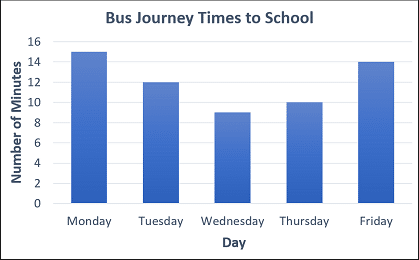
On which day is traffic the heaviest?
A. Monday
B. Tuesday
C. Wednesday
D. Thursday
E. Friday
Correct Answer and Explanation:
The correct answer is (A).
This question is about drawing conclusions from a bar graph. The bars show the different journey times to school. On the day when traffic is the heaviest, it would take the longest time to get to school, so the question is asking you to find the day with the longest journey time. The numbers on the vertical axis go up in twos, so be careful when reading off.
Answer (A): The bar is halfway between the 14 mark and the 16 mark, so it took 15 minutes to get to school.
Answer (B): The height is 12, so it took 12 minutes to get to school.
Answer (C): The bar is halfway between 8 and 10, so it took nine minutes to get to school.
Answer (D): The height is 10, so it took 10 minutes to get to school.
Answer (E): The height is 14, so it took 14 minutes to get to school.
Thus, the longest journey time was on Monday.
Therefore, the correct answer is (A).
MAP 4th Grade Sample Question
Reading Question
Read the passage.
A Lion was sleeping. A Mouse ran over his body. He awoke and caught her. The Mouse begged him to let her go. She said, “Let me go, and I will do you a favor!” The Lion laughed at the Mouse for promising him a favor, and he let her go.
Then, the hunters caught the Lion and tied him with a rope to a tree. The Mouse heard the lion’s roar, ran up, gnawed the rope through, and said, “Do you remember? You laughed, not thinking that I could repay you, but now you see that a favor may also come from a Mouse.”
This passage is an example of which type of text?
A. a myth
B. a play
C. a fable
D. a poem
Correct Answer and Explanation:
The correct answer is (C).
A fable is a short narrative form that is best known for having non-human beings as main characters and ending with a moral. This passage focuses on the Lion and the Mouse and there is a moral at the end of the passage: “A favor may also come from a mouse.” This sentence means that you should not underestimate anyone, because even someone who is weaker, smaller, or less impressive than you in any way has strengths and characteristics you do not possess. Therefore, the correct answer is (C).
Answer (A) is incorrect because a myth is a traditional story consisting of seemingly historical events, though often supernatural. Myths often involve powerful beings or supernatural figures who are the cause of an event.
Answer (B) is incorrect because a play is a form of literature usually consisting of dialogue between characters. It is intended for theatrical performance rather than just reading, which is why there are usually added stage directions and descriptions in brackets.
Answer (D) is incorrect because a poem is a collection of words that express an emotion or idea, with a specific structure and rhythm.
MAP 5th Grade Sample Question
Language Usage Question
Read the sentence.
Jamie told his friend the details of his planned visit to Japan next month.
What is the direct object in this sentence?
A. his friend
B. Jamie
C. the details
D. told
Correct Answer and Explanation:
The correct answer is (C).
A direct object receives the action made by the subject in the sentence. To identify a direct object, first, identify the verb and the subject, and then ask upon whom or what the action is made. Try this on the above sentence:
The verb – told
The subject – Jamie (who performed the action)
Now ask – what did Jamie tell? Jamie told the details of his planned visit to Japan. Thus, Answer (C) is the correct answer.
Note: Do not get confused with an indirect object, which is the part of the sentence that receives the direct object. To identify an indirect object, ask who or what receives the direct object. In this sentence, the direct object is the details, so you should ask: who receives the details? And the answer is – his friend, as Jamie told the details to his friend. Thus, you can eliminate answer choice (A).
Answer (B) is incorrect as Jamie is the subject of the sentence.
Answer (D) is incorrect as told is the verb in the sentence.
MAP 6th Grade Sample Question
Math Question
What type of angle is highlighted below?
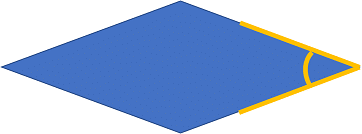
A. Acute angle
B. Straight angle
C. Obtuse angle
D. Right angle
Correct Answer and Explanation:
The correct answer is (A).
The highlighted angle is an acute angle. This means it is smaller than 900, which is a right angle. A right angle forms an L shape:

Therefore, it cannot be answer (D).
Answer (B) is the angle formed by a straight line. A straight angle is 1800:

This is too big for the angle in the shape, so (B) cannot be correct.
Answer (C) is an obtuse angle. This means it is between 900 and 1800.
Here is an example:

This is also much bigger than the angle in the picture, and therefore (C) cannot be correct.
Therefore, the correct answer is (A).
MAP 7th Grade Sample Question
Reading Question
Which of the following words is a synonym (a word that shares the same meaning with another) of the word consequence?
A. ramification
B. publication
C. revelation
D. finalization
Correct Answer and Explanation:
The correct answer is (A).
The word “consequence” shares its meaning with the word “ramification;” both mean “result, outcome.” Therefore, answer (A) is correct.
Answer (B) is incorrect because the word “publication” means “producing printed material.”
Answer (C) is incorrect because the word “revelation” means “disclosure, realization.”
Answer (D) is incorrect because the word “finalization” means “putting in final form.”
MAP 8th Grade Sample Question
Language Usage Question
Read the paragraph.
How do you become a scientist? You should start by completing your school studies. Then, you can think about the field that interests you the most. Once you decide on your favorite field of study, you need to either go to college or university to learn this field of study thoroughly.
Which pattern of organization is used in this writing sample?
A. Compare and contrast
B. Order of importance
C. Cause and effect
D. Sequence
Correct Answer and Explanation:
The correct answer is (D).
When information in a passage is organized by the order in which it occurs or by following a particular order, it is called sequential order. Words commonly used in texts that are organized in sequential order are first, next, the, then, lastly, before, etc.
The most common sequences you will find are stories or series of events that are described as happening one after the other, However, instructions for a series of tasks to perform one after the other certainly apply as well. In this specific text, you are given clear steps that need to be followed to become a scientist, thus this text is organized in a certain order and is a sequential text.
Answer (A) is incorrect as compare and contrast is a pattern of organization where the similarities and differences of two or more things are explored. Nothing is being compared in this paragraph.
Answer (B) is incorrect as in order of importance, the ideas or steps are put in order from the most important to the least important. It is not the case in this paragraph as all of the steps have the same importance.
Answer (C) is incorrect as cause and effect explains how one thing leads or led to another, exploring the reason something happened or what can make something happen, or else the outcome or consequences of of the topic at hand. This paragraph does not describe how each step causes the next, but rather how one needs to be done first and then the next.
MAP 9th-12th Grade Sample Question
Math Question
What is the volume of this object, in cubic units?
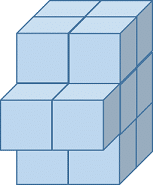
A. 14 cubic units
B. 12 cubic units
C. 11 cubic units
D. 8 cubic units
E. 6 cubic units
Correct Answer and Explanation:
The correct answer is (A).
Volume is the amount of space an object takes up.
To find the volume of this object, you must count the number of cubes that form it.
First, look at the upper part of this object. It consists of two rows, each containing two cubes. Thus, 2 × 2 = 4 cubes.
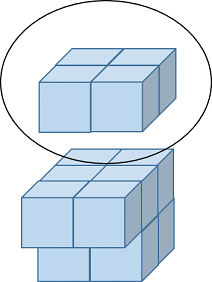
Next, look at the middle part of this object. It consists of three rows, each containing two cubes. Thus, 3 × 2 = 6 cubes.
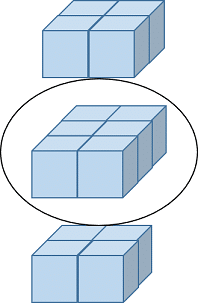
Finally, look at the bottom part of this object. It consists of two rows, each containing two cubes. Thus, 2 × 2 = 4 cubes.
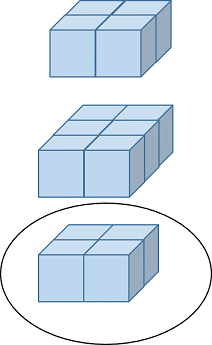
Now, sum up the cubes in each part:
upper part + middle part + bottom part = 4 + 6 + 4 = 14 cubic units.
Therefore, the correct answer is (A).
Language Usage Question
Some members of my extended family were selected to speak at the party, including _____________.
A. me and my mom
B. my mom and me
C. I and my mom
D. my mom and I
Correct Answer and Explanation:
The correct answer is B. “my mom and me.”
“I” is always used as a subject, and “me” is always used as an object. Whenever there are nouns in relation to a verb, the subject is the noun that does the verb, and the object is the noun that the verb is done to.
In this sentence, the ones that did the selecting (even though they are not mentioned) would be the subject, and the ones that were selected are the object. The narrator and his mother were selected, so the word “me” is used, not “I.” When referring to one’s own self along with another, whether as the subject or the object (“I” or “me”), the other is always listed first. These two factors leave us with B as the only option.
Get Access to Valuable Practice Resources for Any Grade
Unlock an array of valuable practice resources tailored specifically for MAP testing preparation. Whether your child is getting ready for the MAP test or you’re seeking targeted support to enhance their skills, explore a diverse range of map practice tests designed to boost understanding and confidence.
From interactive exercises to subject-specific quizzes, these resources cater to various learning styles, ensuring a well-rounded preparation for MAP testing success:
- Map Kindergarten Practice Tests
- MAP 1st Grade Practice Tests
- MAP 2nd Grade Practice Tests
- MAP 3rd Grade Practice Tests
- MAP 4th Grade Practice Tests
- MAP 5th Grade Practice Tests
- MAP 6th Grade Practice Tests
- MAP 7th Grade Practice Tests
- MAP 8th Grade Practice Tests
- MAP 9th-12th Grade Practice Tests
Understand How the MAP Scores Work & What They Mean
MAP scores provide valuable insights into your child’s academic progress. Let’s break down the key aspects:
How Are MAP Tests Scored?
MAP tests use RIT (Rasch unit) scores, which represent a point on a continuous scale of learning. These scores are not targets or benchmarks but indicate your child’s current level of performance in specific subjects. The scores are like marking your child’s height on a growth chart – they show where your child is at a given point in time, helping measure educational growth.
What Is a Good MAP Test Score?
There isn’t a specific “good” score as MAP tests focus on growth. However, scores typically range from 140 to 300. Students progress from the 140-190 level in third grade to the 240-300 level in high school. Understanding your child’s RIT score and growth is more crucial than a single numerical value.
What Is an Average MAP Test Score?
An average starting point for third graders is around 140-190, with high school students reaching the 240-300 level. These scores offer a continuous measurement, allowing you to follow your child’s educational growth from year to year.
What Is a RIT Score?
A RIT score is a continuous scale indicating a student’s achievement level. It’s not evaluative but helps measure growth. A higher RIT score doesn’t mean a student is “better” but rather that they’ve reached a higher level on the learning scale. Understanding your child’s RIT score is key for tracking their educational development over time.
See Answers to Frequently Asked Questions By Parents
Explore detailed answers to common questions about MAP testing:
Can Homeschoolers Take the MAP Test?
Homeschoolers have the opportunity to participate in MAP testing. The assessment is not confined to traditional school settings, offering flexibility for homeschooling families to evaluate their child’s academic progress.
Can Dictionaries Be Used on MAP Testing?
Bilingual dictionaries are allowed during MAP testing, but they must be limited to word-to-word translation only. Dictionaries with definitions and/or examples are not permitted to ensure a fair evaluation of independent skills.
Can the MAP Test Be Taken on the Phone or Laptop?
The MAP test can only be taken on desktop and laptop computers, including Chromebook devices. This ensures a standardized testing environment and consistent experience for all students.
Can Students Use a Multiplication Chart on MAPS Testing?
Calculation devices, including multiplication charts, are not allowable during MAP testing. However, students can create their multiplication charts on their scratch paper to aid them with their calculations.
Can You Use a Calculator for NWEA MAP Testing?
Calculation devices, including calculators, are permitted during NWEA MAP testing. However, they should not have labels or instructions, and students should be familiar with using them during instruction for an accurate assessment.
Do Students Get Accommodations on the MAP Test?
Absolutely. MAP testing accommodates students with special needs. This includes providing additional time for students who may require it to ensure a fair and accessible testing environment.
Does Time Matter on the MAP Test?
No, MAP Growth tests are not timed. Some students may require more time, and the flexibility exists to accommodate this. If a student does not finish the test in the allotted time, it can be suspended, and the student can continue at a later time.
What Happens if a Student Misses a MAP Test?
If a student misses a MAP test, schools typically provide options for makeup testing. It’s crucial to communicate promptly with the school to address any missed assessments and determine an appropriate plan.
What Happens if You Don’t Complete a MAP Test?
If a student is unable to finish the test within the designated class period, they are permitted to continue and complete the test on the following day. This flexibility ensures that students have adequate time to demonstrate their abilities without unnecessary time constraints.
Conclusion
Congratulations on taking the proactive step to familiarize yourself with the MAP Growth test! By understanding the ins and outs of this assessment, you’ve empowered yourself to guide your child through a successful testing experience.
Now that you know how to prepare effectively, don’t hesitate to dive into the wealth of MAP practice questions tailored to every grade level. Accessing valuable resources, such as those offered by this test prep website, can further enhance your child’s preparation.
As you navigate the MAP scores, remember that it’s not just about the numbers but the continuous journey of growth they represent. Lastly, if you ever have questions, the FAQs provide insightful answers to common queries. You’re on the right track to supporting your child’s educational journey, and your dedication is the key to their success! Happy testing!
